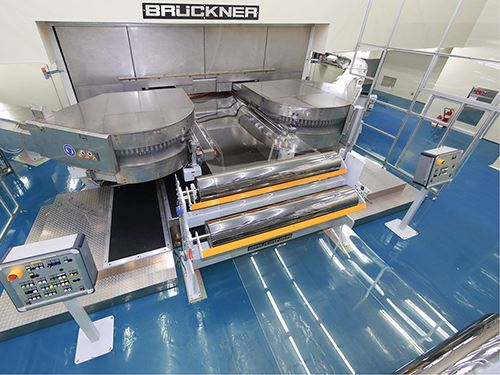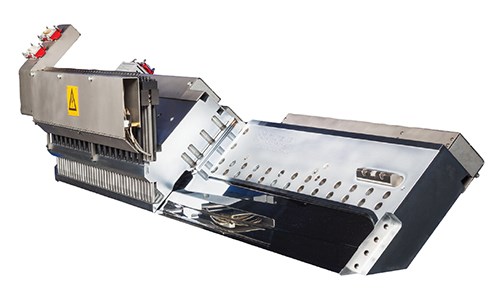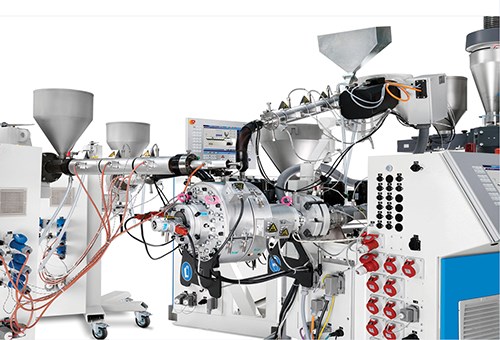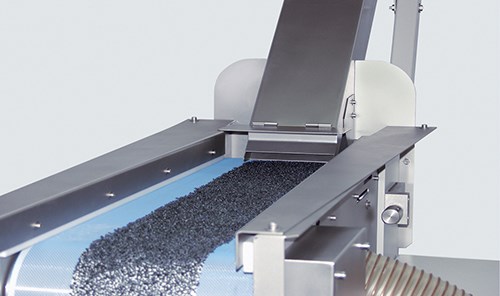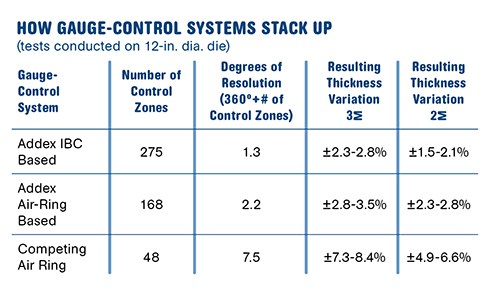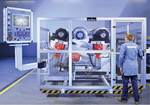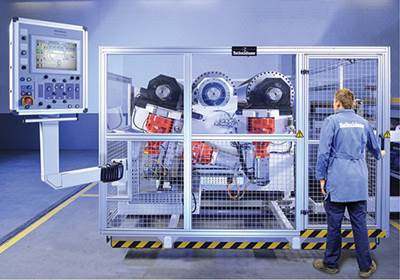K 2013 Preview: Extrusion, Compounding, Recycling
Across all extrusion technologies, expect to see new standards in speed, quality, flexibility, and efficiency in both energy and material usage.
In extrusion, more envelopes will be pushed during K 2013 than at your local post office. Across all extrusion technologies, expect to see new standards in speed, quality, flexibility, and efficiency in both energy and material usage. There will also be news in compounding and recycling equipment.
FASTER, BETTER QUALITY BLOWN FILM
Windmoeller & Hoelscher (U.S. office in Lincoln, R.I.), is keeping its news mostly under wraps until show time, but it did reveal that it will introduce what it calls a “unique new film extrusion concept that runs at extraordinary speeds without sacrificing quality.” Code named Project E-24, the new technology is said to be energy efficient and will minimize downtime and expedite changeovers.
Hosokawa Alpine (U.S. office in Natick, Mass.) was equally secretive about its show news, divulging only that it will display two “technological firsts” aimed at providing maximum flexibility and high output rates with consistent quality.
As reported in our last issue (see Close Up), Reifenhauser-Kiefel (U.S. office in Wichita, Kan.) will be showing a new film-flattening device called the Evolution Ultra Flat unit. This is installed between the hauloff nip-roll assembly and turner-bar system, which Reifenhauser says is an ideal place for stretching and flattening because the film is still warm and more malleable.
Other suppliers were less coy about their new entries. Addex Inc., Stoughton, Mass., will show its newly developed Automatic Gauge Control System (AGC). Trends in electronic miniaturization and distributed controls have allowed Addex to include various functionalities directly inside each component, which facilitates retrofits.
These functionalities include direct control of the high-resolution air flow within the dual-flow cooling ring. Operators just input a 360° profile of desired cooling-air flow, and the air ring takes it from there. The new system also provides direct control of even higher resolution air flow within Addex’s internal bubble cooling (IBC) system, using the same interface as for the cooling ring. For a fully integrated autoprofile control algorithm, operators just input an already mapped 360° thickness profile and the system will determine the best control action and seamlessly pass this to the cooling adjustors of the air rings.
Addex also has a solution for processors that have an existing thickness profiler but don’t have the ability to sort through all the intricacies of line speed. It’s called the Addex Mapper, a stand-alone device that directly accepts most thickness profiler system profiles and then automatically takes into account all the twists, turns, and undulations of the bubble to create a fully “mapped” thickness profile with better than 1° accuracy. This profile runs continuously, even during oscillating hauloff reversals.
For film processors with no thickness profiler, Addex’s ALF capacitive sensor module allows for direct measurement of thickness to the Mapper within the collapsing frame, using oscillating hauloff motion for highly accurate profiling. Up to two ALFs—one on each side of the collapsing frame— can be used for faster response. Other sensor technologies can be used optionally in both positions, such as noncontact capacitive and nuclear.
An optional Profile Module offers the fastest control possible, Addex states. This setup adds a separate profiling ring that allows for all sensor technologies to be scanned automatically around the bubble. The results feed automatically to the Mapper and then on to Addex’s external gauge-control air ring for a total system control solution.
Processors with earlier iterations of Addex Auto Profile technology can upgrade their systems with some or all of these enhancements via addition of a Cooling Profiler Convertor Module. This places all of its previous designs on the latest Ethernet subsystem and eliminates all the wiring except for Ethernet and power.
In blown-film dies, Macro Engineering & Technology Inc., Mississauga, Ont., has redesigned its CenterPack coextrusion die to improve processing versatility and minimize residence time. The layer ratio of the die has been improved from 3:1 to 4:1, and residence and purging time has been reduced by 40-50%. With these upgrades, the new CenterPack die is now capable of processing both blown and cast film resin grades without any interlayer clarity issues, says the company.
Available for up to nine layers and die diameters to 2 meters, the redesigned CenterPack die can be used on a wide range of materials. The stackable design uses a center-fed system that ensures minimum residence time and fast purging and delivers flat film with gauge variations of better than ±5% (2 sigma), says Macro.
UPGRADED FLAT FILM, SHEET SYSTEMS
In flat film, Davis-Standard, Pawcatuck, Conn., will introduce what it says is the first in-line pre-stretch system for cast film that enables processors to run thinner at higher speeds. Called the dsX stretch, the 2-meter-wide line reportedly offers a small footprint and can be supplied within a six-month lead time with both five- and seven-layer options. Davis will also introduce the dsX flex-pack extrusion coating line, a pre-engineered system aimed at processors looking for a quick, versatile entry into the extrusion-coating market. The dsX flex-pack can be delivered within six months and is available in two different layouts to accommodate virtually any plant space requirements.
A new high-performance stretch-film line from Austria’s SML (U.S. contact: American Starlinger-Sahm, Inc., Greenville, S.C.) allows for film production 3 meters wide in a 6-up configuration at rates to 5300 lb/hr. Called SmartCast, the modular design offers the choice of four preconfigured extrusion units for five or seven layers. An optional edge-encapsulation system permits production speeds up to 750 m/min.
SML also upgraded the chill-roll unit by adding more functions, minimizing vibration, and making it easier to operate. And its newly developed W4000-4S winder makes machine and jumbo rolls on 3-in. cores and hand rolls on 2-in. cores. It offers both coreless and thin-core technology and a reduced film tail for an improved roll finish.
For BOPP processing, Brückner Maschinenbau (U.S. office in Portsmouth, N.H.) will introduce new lines that run significantly faster than the 1720 ft/min of previous equipment. Higher speeds are possible primarily because the firm (brueckner.com) has upgraded both its machine- and transverse-direction orientation (MDO/TDO) units. A new MDO has automatically adjustable contact rolls for more stable production at high speeds. The TDO features a new geometry for more efficient power transmission.
For biax-oriented PET, Brückner will show a handful of new technologies aimed at boosting line speeds beyond the current standard of 1600 ft/min. Web-pinning to the chill roll is optimized by a new automatic control system. This permits PET film to run at high speeds without pinning-agent additives. This MDO on this line offers “two-gap stretching” and now has been fitted with innovative adjustments for a closed power flow. In the TDO, a new low-vibration transport system ensures optimal stability at high speed and longer lifetime.
Battenfeld-Cincinnati will display its Multi-Touch sheet roll stack, which debuted at last year’s NPE2012 show in Orlando, Fla. Conventional film and sheet cooling units consist of three-roll stacks; the Multi-Touch uses a larger number of roll nips to provide more reliable cooling of the material on both sides. The unit is equipped with a two-roll stack for preliminary calibration and three, five, or seven rolls for final calibration. The first rolls have a larger diameter to minimize deflection. Reifenhauser will also introduce Mirex MT polishing-stack technology. The patent-pending unit allows for automatic digital nip adjustment, even during production runs, eliminating the need for manual, trial-and-error nip adjustments that require stopping the line. With no hydraulics, the Mirex MT is suited for clean rooms.
In extruders, high speed is all the rage. Battenfeld-Cincinnati will display an extruder capable of up to 1500 rpm, specifically for packaging applications. The unit has a 75-mm screw and can be furnished with drive units in four different sizes. The extruder is said to cut energy consumption up to 25% compared with a conventional unit with the same output. For PP processing, the extruder provides throughputs in excess of 3300 lb/hr, and more than 4400 lb/hr for PS.
Brückner will show its high-speed extruder for cast film that reportedly offers a 30% reduction in energy use compared with previous designs.
As reported last month, Reifenhauser will show a novel extruder line called the Evolution series. While most details about it were a secret at press time, the extruder will feature an Energizer screw that “will avoid useless energy input, reduce energy consumption, and lower melt temperature by as much as 20° C (68° F) without compromising melt quality or output.”
Welex, Blue Bell, Pa. will highlight its new Converge CTS Sheet Line, which uses conical twin-screw extrusion technology as opposed to the more typical parallel designs offered by other suppliers. The line is for undried PET and PLA sheet.
Gneuss’ display with include its MRS (multi-rotation system) 160 extruder with a throughput of more than 3000 lb/hr. One major application for this machine series has been undried PET sheet, says Gneuss (U.S. office Charlotte, N.C.). The MRS is a drum containing eight satellite single screws driven by a ring gear and pinion transmission. The “barrels” cut into the drum are approximately 30% open and provide optimum exposure of the melt, says Gneuss.
A new line for foamed sheet product development from KraussMaffei Berstorff combines a modular twin-screw ZE 40 UTXi Modular for material melting and mixing with a KE 90 single-screw extruder for melt cooling. The firm developed the new system because it says production machines are not economical for testing new processes or modifying process parameters.
A new mixing device from Promix Solutions AG (promix-solutions.com), Winterthur, Switzerland, is designed to equalize the temperature and velocity of the melt over the whole cross-section and distribute additives perfectly. This leads to consistently high product quality and might even allow a higher throughput. The patented melt blender, called the SMB plus, provides low pressure drop and a very robust, seamless construction, the company says. Furthermore, the SMB plus features excellent self-cleaning properties thanks to a flow-optimized design.
Cloeren Incorporated, Orange, Tex., will show the moebius‐manifold die for flat film and sheet. Three versions will be displayed: one for single-layer, a second for coextrusion, and a third that will be teamed with Cloeren’s patented IDS (Internal Deckle System). Visitors will be able to see the features of the manifold because all three dies will be cutaways.
The patent pending die is said to minimize if not eliminate chamshell deflection by utilizing a varying aspect ratio. The initial larger teardrop cross‐section—located at the centerline—transitions to a smaller cross‐section along the width to the manifold end, while maintaining a constant manifold length by varying the transition angle of the manifold. This allows the manifold to be constructed having a backline parallel to the die lips to mitigate clamshell deflection.
POTENT PIPE SYSTEMS
For polyolefin pipe, Battenfeld-Cincinnati will launch a new machine series, the GL (for gearless) version of its solEX single-screw extruders that debuted at K 2010. A new high-torque motor is said to be more energy-efficient than conventional motors. It also offers lower noise and vibration levels and requires virtually no maintenance. Machine footprint is reduced because there is no gearbox. The series is available in 45-, 60-, 75- and 90-mm sizes.
In twin-screw developments for PVC window profiles, Battenfeld-Cincinnati will show a conEX 63 P conical twin piggybacking on a twinEX 78-34P extruder. The combination achieves an output of about 1100 lb/hr and is said to be particularly suited to formulations that include up to 40% by weight regrind.
Downstream, the ability to switch from one pipe size to another has been enhanced by the QuickSwitch from KraussMaffei Berstorff to include the 250-450 mm diameter range. The system is said to provide extremely economical use of energy and material during size changes.
QuickSwitch systems can be equipped with the company’s cost-saving internal pipe cooling (IPC) technology. With IPC, pipe is cooled from the inside using ambient air, which is suctioned with help of a side-channel compressor. As well as reducing space and investment costs, use of ambient air reduces the need for cooling water. The machine builder will also show a range of technologies for producing multi-layer pipe.
Theysohn Extrusionstechnik, Korneuburg, Austria (theysohn.at), will display a wide range of machines for pipe and profile. Among these will be the CON 68, a new, conical twin-screw extruder for outputs up to 770 lb/hr. This machine was developed specifically for duct, pressure, and sewage pipes up to 110 mm (4.3 in.). Theysohn will also show a three-layer PVC pipe system with a foam or scrap core and a dual-strand line for PVC pipe up to 3 in.
In tubing, Davis-Standard will show a new dsX med-tube line for high-performance medical applications. In a coextrusion setup, each extruder is equipped with a gear pump, giving it the flexibility to process a wider range of medical-grade materials. The line also provides a small footprint.
American Kuhne, Ashaway, R.I. will show extruder technologies for tubing that offer energy savings, quick changeover, and flexibility.
Conair, Cranberry Township, Pa., will show its ATC dual-spindle coiler for winding small, flexible extrusions. Little or no friction or winding tension is generated, preventing deformities in delicate products and suiting the unit to medical tubing, small tubes, filled cords, and small flexible profiles. Fully automated transfer of winding to a new reel means there is no operator involvement or process disruption, which effectively increases line speed and performance during changeover.
Beta LaserMike, Dayton, Ohio (betalasermike.com), will display a myriad of measurement technologies for pipe and tubing. Among these will be the UltraScan system, an ultrasonic gauge that provides noncontact precision measurement of product wall thickness, eccentricity, diameter, and ovality. It can measure wall thicknesses down to 0.001 in. on tubes as small as 0.010 in. diam. and larger products up to 26.0 in.
Beta LaserMike will also exhibit the latest AccuScan 5000 series of high-speed diameter and ovality gauges. The firm will also show the LaserSpeed noncontact gauge for measuring the length and speed of products. This measurement solution delivers better than ±0.02% repeatable accuracy, recommending it for replacing error-prone, high-maintenance contact tachometers. The latest version of this gauge, the LaserSpeed 9000, detects both forward and reverse directions as well as zero speed (non-moving product).
COMPOUNDING & RECYCLING
In compounding, many builders of twin-screw extruders are waiting until show time to announce their developments.
In pelletizing, Maag Automatik (U.S. office in Charlotte, N.C.) will show the Duro belt dryer for abrasive and sensitive compounds. Used primarily in underwater pelletizing, the Duro belt dryer is said to offer significantly lower operating costs because the innovative design of its pellet-contacting components produces very little wear.
The machine gently dries glass-reinforced products or highly mineral-filled compounds to residual pellet moisture levels of less than 0.1 %. Gentle treatment of the pellets minimizes dust and greatly enhances product quality, says the company. The dryer is also said to be suitable for frequent product changes because it is very quick and easy to clean.
Gneuss will show an extrusion line consisting of its Multi Rotation System Extruder MRS 130 and two fully automatic filtration systems, the RSFgenius and RSFgenius 250. Two filtration systems are needed because this particular line is designed to process up to 2200 lb/hr of PET bottle flake directly into continuous filament.
Gneuss will also unveil the SFXmagnus series of filters designed for applications with a lower contamination levels, where back-flushing makes sense, but where frequent back-flushing cycles are not absolutely necessary. Gneuss will also introduce the SFpvc filter for PVC processing and recycling.
Maag will launch a screen changer that is said to have up to four times more filter area than conventional systems. The new line adapts the patented design of Maag’s large-area polymer screen changer to the special needs and filter requirements of the extrusion industry. Thanks to the new shape of the pistons, which are fitted with curved breaker plates, 75% of the active piston surface acts as filtration area.
The STF Group, Aicha vorm Wald, Germany will debut the STF-LS Label Scrapper, designed for dry removal of bottle labels. The machine offers 95% removal of labels and full body sleeves from PET bottles with minimal damage to the bottle itself and without loss of necks or caps. Zimmer America Corp., Spartanburg, S.C., represents STF in North America.
Read Next
Reifenhauser to Unwrap New Extruder, Other Innovations
New machine and novel approaches in blown/cast film, sheet, and wood composites touted.
Read MoreFor PLASTICS' CEO Seaholm, NPE to Shine Light on Sustainability Successes
With advocacy, communication and sustainability as three main pillars, Seaholm leads a trade association to NPE that ‘is more active today than we have ever been.’
Read More

